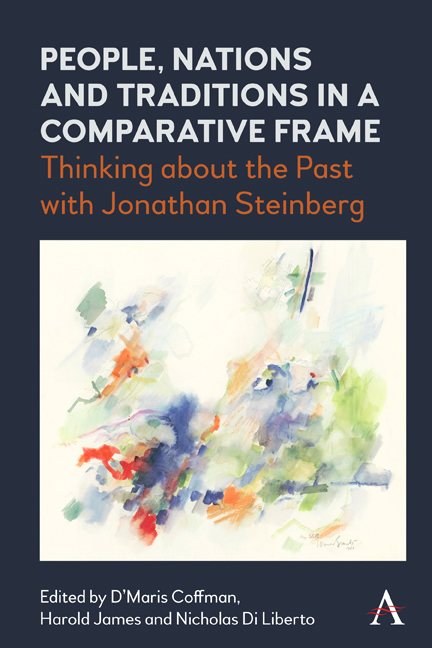 People, Nations and Traditions in a Comparative Frame
People, Nations and Traditions in a Comparative Frame Book contents
- Frontmatter
- Contents
- Foreword
- Acknowledgements
- Notes on Contributors
- Introduction
- Part One Methodological Pluralism and New Applications
- Part Two Personal and National Character
- Part Three Society, Families and the Sovereign Self
- Part Four History Out of Sync: Modernity and Tradition
- Part Five History, Narrative and the Human Condition
- Afterword
- Bibliography of Jonathan Steinberg’s Works
- Index
Chapter Fifteen - April 1945: Life and Death in the Last Days of World War II
Published online by Cambridge University Press: 23 February 2022
- Frontmatter
- Contents
- Foreword
- Acknowledgements
- Notes on Contributors
- Introduction
- Part One Methodological Pluralism and New Applications
- Part Two Personal and National Character
- Part Three Society, Families and the Sovereign Self
- Part Four History Out of Sync: Modernity and Tradition
- Part Five History, Narrative and the Human Condition
- Afterword
- Bibliography of Jonathan Steinberg’s Works
- Index
Summary
All wars have their final casualties, whether World War II or Vietnam or Afghanistan, lives lost with peace so achingly close that it is almost a palpable presence. No matter how just or noble – or wicked – the cause, no one wants to be among the last names added to the list of the war's victims. That was particularly true in the spring of 1945 when, for the first time, it actually seemed possible to make it to the end, to survive.
Spring 1945 witnessed a crescendo of tumultuous events that presaged the final collapse of the Third Reich: the final Russian assault on Berlin, the Anglo–American drive across Germany and the liberation of the concentration camps. What follows are two powerful personal stories that capture, from very different perspectives, the experiences of those struggling under the strains of the war's final weeks. They are not stories of policy makers or military leaders but ‘ordinary’ men, who found themselves caught up in the maw of a terrifying conflict over which they had no control. Dick Farrington was a journalism major at the University of Missouri when he volunteered for the Army Air Corps in 1942. He hoped to be a novelist when it was all over. In the spring of 1945, he was the pilot of a B-24 Liberator flying bombing missions deep into Germany, his tour of duty almost at an end. ‘Don't worry too much about me’, he wrote to his folks in early April, ‘getting along pretty good so far (knock on wood). Just trust in God as I do and remember, I’m always right in there doing all I can to help him look out for me.’ With over 20 missions behind him, he was two-thirds of the way through his tour of duty and felt confident that the war in Europe would end before he could finish his 35 missions – at least, he added, ‘I hope, I hope, I hope.’ Four days later, on 21 April, his plane, the Black Cat, would take him over the Bavarian city of Regensburg on the penultimate American air raid of the European war. It would be the last American bomber shot down over Germany in World War II.
- Type
- Chapter
- Information
- People, Nations and Traditions in a Comparative FrameThinking about the Past with Jonathan Steinberg, pp. 225 - 240Publisher: Anthem PressPrint publication year: 2021


